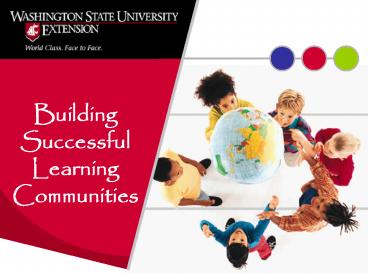Building Successful Learning Communities - PowerPoint PPT Presentation
1 / 42
Title:
Building Successful Learning Communities
Description:
Learning Communities? Multiple Learning Styles. Brain Based ... Professional Learning Community Data. 40 Developmental Assets. Emotional Intelligence Research ... – PowerPoint PPT presentation
Number of Views:28
Avg rating:3.0/5.0
Title: Building Successful Learning Communities
1
Building SuccessfulLearning Communities
2
Bingo
- As you come in,
- grab a bingo
- sheet and try to
- get 5 in a row?
2
3
Introductions
Scott VanderWey, MS ED WSU Experiential
Education Director Puyallup, WA Cody Stitt, MS
ED WSU Experiential Education Coordinator
Wenatchee, WA
3
4
Land Grant Universities
4
5
5
6
Check-In
Activity Directions Turn and introduce
yourself to someone you are sitting next to and
share where you live, and one thing you are
looking for in this session.
7
Shared Outcomes
- What are we
- looking for together?
7
8
Shared Norms
- Be Here
- Get the most out of our time together
- Be Open
- Open to Sharing Listening to new ideas
- Be Caring
- Physically, Emotionally Intellectually
8
9
Movie Clip
9
10
Popcorn Share
- What is worth
- fighting for?
10
11
Shared Purpose
- To discover those
- things worth
- fighting for!
11
12
Learning Community Model
12
13
Why Build Learning Communities?
13
14
Why use Best Practices?
14
15
15
16
What Impacts Learning?
Shared Norms
16
17
17
18
18
19
Powerful Teaching
6
19
20
Component 4 Students Are Engaged in Active
Participation, Exploration, and Research
73
20
21
Journal Topic
Why do you think powerful teaching and learning
is used only 17 of the time in schools?
21
22
Why do we see powerful teaching and learning
only 17 of the time?
- Three possible reasons
- 1.Teachers do not know how to teach this way.
- 2.Teachers do not have the time or energy to
prepare these types of lessons. - 3.Teachers do not believe kids can do this type
of learning.
22
23
Creating Lasting Change
First Order Changes Specific Classroom and
School-wide practicesChanges in efficiency,
organization, specific practices change without
difference
Second Order Changes Philosophy, focus and
ownership Systemic change, fundamental ethos,
philosophy, beliefs driving practice
restructuring (corporate culture)
23
24
The Flow of Change
24
25
Growth Circles
25
26
- The willingness to take risks, ask questions and
make mistakes is a requirement for learning. - Deborah Meier (In Schools We Trust)
27
Learning Community Model
27
28
Basic Needs
28
29
Learning Community Model
29
30
What is student Success?
30
31
40 Developmental Assets
31
32
Discussion Circles
- Get in a circle around
- one of the ropes.
- Pass the knot around
- and share your ideas
- to the questions
- Presented.
32
33
Research Based Outcomes
Increased Commitment to School
Reduced Suspensions
More Time Devoted to Schoolwork
Less Behavior Issues
Improved Graduation Rate
Improved Post-grad Employment Rates
Increased Mastery of Subject Material
Increased Positive School Climate
(Hawkins et al., 1999 Malecki Elliot,
2002)
Improved attendance
Reduced Expulsions
33
34
Shared Membership
34
35
Shared Purpose
35
36
Shared Norms
36
37
Shared Skills
37
38
Shared Outcomes
38
39
Movie Clip
39
40
Web Resources
- www.ncw.wsu.edu/learningcommunities
40
41
Text Message
- What did you get
- out of our
- time together?
41
42
Building SuccessfulLearning Communities































